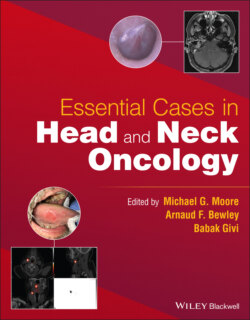Читать книгу Essential Cases in Head and Neck Oncology - Группа авторов - Страница 73
Physical Examination
ОглавлениеThin, adult male in mild distress from pain but breathing comfortably.
Skin: no suspicious lesions.
Oral cavity and oropharynx: 3 cm right‐sided nodular tumor arising from the tonsillar bed.
Neck: cervical exam reveals no palpable lymphadenopathy or salivary lesions.
Cranial nerves II–XII intact.
Flexible fiberoptic laryngoscopy: large right tonsillar mass. The epiglottis is displaced inferiorly and posteriorly on exam. The view of the glottis is limited but without any apparent involvement, and the true vocal folds are bilaterally mobile.
Contrasted CT of the neck was performed (see Figure 10.1).
Question: What is the next appropriate step in management?
Answer: Histopathologic diagnostic confirmation is recommended prior to proceeding with next steps in treatment. In this instance, this can likely be performed via a transoral office biopsy. If exposure is a challenge and/or there are concerns for significant bleeding due to the tumor appearance or a patient being on anticoagulation, a panendoscopy under general anesthesia could be performed.
Biopsy confirms diagnosis of SCC, p16 negative.
Question: Are any further imaging studies appropriate?
PET/CT: yes/no. This is an ideal imaging study as it will reveal the extent of the recurrence, evaluate for regional and distant disease, and assess for a second primary lesion.FIGURE 10.1 AxialAxial CT image.FIGURE 10.2 18FDG‐PET/CT axial view demonstrating an intense right tonsil tumor with an SUV of 16.6. No regional or distant lesions were noted.
MRI neck: yes/no. MRI can provide increased soft tissue detail when evaluating cancers of the oropharynx. This may be particularly beneficial in this case when assessing for parapharyngeal space extension. Evaluation for retropharyngeal lymphadenopathy is also important. An MRI is unlikely to yield more information in this patient that will alter management compared with the information available from the CT neck with contrast. Although not strictly contraindicated its value is limited in this patient.
Ultrasound: yes/no. This study is not indicated because given the location of the primary tumor adjacent to the mandible, the bone would preclude complete evaluation of the primary cancer.
Chest CT: yes/no. If a PET scan is not obtained, a chest CT would be helpful to assess for distant disease or a recurrence of his lung cancer.
An 18FDG‐PET/CT was performed from skull base to midthigh (see Figure 10.2) due to the recurrent oropharyngeal cancer, as well as the history of lung cancer. The patient was then presented at a multidisciplinary tumor board.
Question: What is the most appropriate therapeutic management for this patient?
Answer: Open radical tonsillectomy with clear margins, ipsilateral neck dissection and free flap reconstruction. Due to the proximity of the lesion to the internal carotid artery, the risk of life‐threatening hemorrhage, and the patient's prior definitive treatment with chemoradiation, open approach is favored over TORS. While TORS has been shown to be a safe and effective alternative to open resection of oropharyngeal malignancies in the salvage setting, this patient's anatomy is better suited for an open approach, which will allow dissection directly on the vessel, as well as proximal and distal control. Reirradiation, palliative chemotherapy, or hospice may be considered in poor operative candidates, in those with more advanced disease, or in patients who refuse surgery.
The patient's case was presented at the institutional Multidisciplinary Head and Neck Tumor Board, and open resection with right neck dissection and reconstruction via lip split and mandibulotomy approach, tracheostomy, and percutaneous endoscopic gastrostomy were undertaken. Sacrifice of the lingual nerve was necessary due to the location of the tumor, but the hypoglossal nerve was preserved. The specimen was removed en bloc, and the defect exposed the parapharyngeal carotid and radiated fat of the parapharyngeal space and the prevertebral fascia. Right neck dissection required resection of some branches of the external carotid artery, but all tumor was removed from the neck, and the internal jugular vein and the internal carotid artery were preserved.
Question: What is the best reconstructive option for this patient?
Answer: Due to the history of prior radiation therapy, the proximity to the carotid artery as well as the wide communication of the primary site resection and the neck, a vascularized flap reconstruction is required. Free tissue transfers have largely supplanted regional flaps for large oropharyngeal and oral cavity reconstruction in appropriate candidates, but because of this patient's comorbidities and poor recipient vessels, a regional flap reconstruction with the pectoralis major myocutaneous flap was performed (see Figure 10.3). A segment of skin with the flap is required for approximation with pharyngeal mucosa to ensure a water‐tight closure. Despite the favorability of free tissue transfer in oropharyngeal reconstruction, the pectoralis major myocutaneous flap remains a viable reconstructive alternative in patients who are not candidates for free flaps. A nonvascularized repair such as a skin graft or acellular dermal autograft would be inappropriate here given the large communication with the neck wound, poor tissue quality, the prior radiation, and the proximity to the internal carotid artery.
FIGURE 10.3 This intraoperative photo demonstrates an open approach to the oropharynx via lip split and paramedian mandibulotomy. The tumor has been excised and the defect reconstructed using a pectoralis major myocutaneous flap.
The patient failed a follow‐up modified barium swallow study and remained PEG‐dependent after surgery.
Final pathologic evaluation of the surgical specimens revealed a pT2N0M0 moderately differentiated SCC that was completely excised with >5 mm margins. Perineural invasion was present, but there was no lymphovascular invasion. Tumor immunohistochemical staining for p16 was negative. Reirradiation was discussed at tumor board, but observation was favored due to clear margins.
